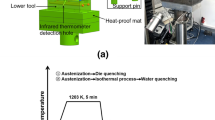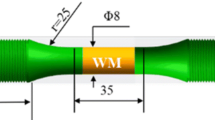Conclusions
-
1.
In the case of moderate cooling rates during thermal cycling, boriding increases the thermal fatigue resistance of nickel alloy KhN70VMYuT, but lowers the thermal fatigue resistance in the case of rapid cooling. The heating rate has no noticeable effect on the thermal fatigue resistance of borided alloy KhN70VMYuT.
-
2.
Machine parts of alloy KhN70VMYuT can be subjected to diffusion boriding without lowering the thermal fatigue resistance only in the case where cooling from the maximum temperature during operation occurs at a moderate rate—in air, for example.
Similar content being viewed by others
Literature cited
E. V. Akulinichev and I. A. Brovkin, in: Reports of the Kaluga Branch of the N. É. Bauman Moscow Technical College [in Russian], No. 3, Mashinostroenie, Moscow (1970).
A. M. Borzdyka (editor), Heat Resistant Metallic Materials [Russian translation], Moscow (1958).
Additional information
Kaluga Branch of the N. É. Bauman Moscow Technical College. Translated from Metallovedenie i Termicheskaya Obrabotka Metallov, No. 6, pp. 51–52, June, 1972.
Rights and permissions
About this article
Cite this article
Akulinichev, E.V., Akulinicheva, A.N. Thermal fatigue resistance of borided alloy KhN70VMYuT. Met Sci Heat Treat 14, 522–523 (1972). https://doi.org/10.1007/BF00648309
Issue Date:
DOI: https://doi.org/10.1007/BF00648309




